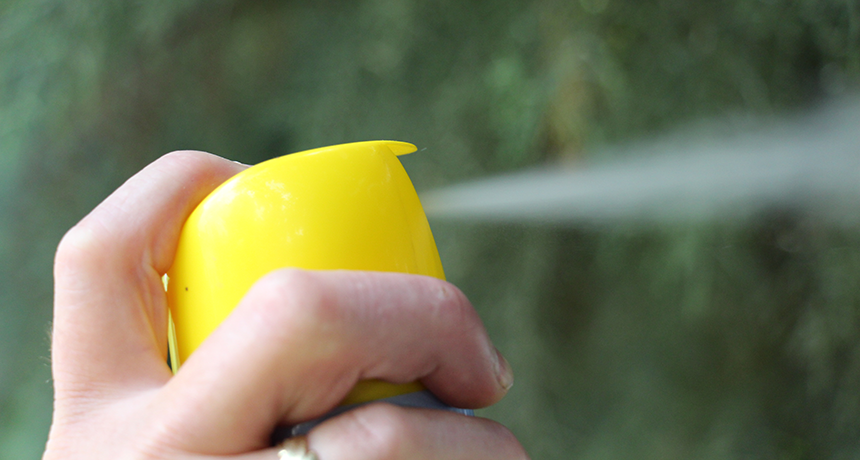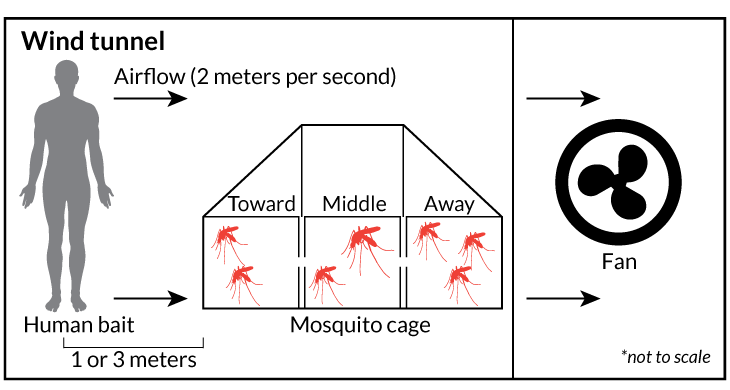Analyze This! Mosquito repellents that work
Spray-on repellents are usually the best at keeping those blood suckers from making you their next meal

Does the best mosquito repellent come in a spray can? To find out, scientists put common products to the test.
redstallion/iStockphoto
Summer is here. And it’s time to choose a repellent to avoid itchy and potentially dangerous mosquito bites. There are plenty of deterrents to choose from. These include sprays, citronella candles and wearable devices. But which is best? We look to data for the answer.
Earlier this year, scientists tested the effectiveness of several mosquito repellents. Those treatments included the OFF! clip-on fogger; Cutter Lemon Eucalyptus spray; a 98 percent solution of DEET, which stands for diethyltoluamide (Dy-ETH-ul-TAAL-yu-ah-myde); a spray made from 40 percent DEET; an herbal spray; and Avon Skin-So-Soft.
The researchers built a mosquito cage with three sections and placed it in a wind tunnel. Each of the volunteers then spent time becoming bait for the Aedes aegypti (AY-deez Eh-JIP-tye) mosquitoes. One by one, the recruits stood at the end of the tunnel that was furthest from a high-powered fan that was pulling air out of the test chamber. Sometimes the recruits were 1 meter (a bit more than 3 feet) in front of the cage, other times 3 meters from it. (Because the mosquitoes were screened in, the volunteers never got bit).

The fan pulled the scent of the volunteer and the repellent through the mosquito cage. The researchers then measured the share of mosquitoes (in percent) that flew toward the person wearing or placed near each repellent. And for each repellent, the scientists repeated the bait test four times.
The wearable OFF! Battery-powered clip-on fogger performed best in the wind tunnel. It actually killed mosquitoes. But the researchers note that those bugs were all in a screened cage. That meant they couldn’t escape the repellent’s chemical.
Although the fogger is very effective in such a controlled environment, it might not work best outdoors. If someone using the fogger was sitting still and there wasn’t much wind, the repellent vapor would stay where she was and should prevent mosquito bites. But for activities like hiking, biking or playing outside, the fogger may work less well. Moving around a lot could prevent the repellent vapor cloud from surrounding the wearer completely enough to repel many mosquitoes.
The advantage of sprayed-on repellents is that they would move with you, whatever your activity. Moreover, some of the sprays were nearly as effective as the fogger, even in the wind-tunnel tests. The best performing sprays contained either DEET or oil from the lemon eucalyptus plant.
Bracelets, the citronella candle and a wearable device that makes high-pitched noises (meant to drive mosquitoes away) all performed poorly in the tests. Each was little better than using no repellent at all.
This table summarizes the results of the experiments:
Repellents face-off
Researchers measured the attraction rate of mosquitoes to someone wearing or using mosquito repellents. No repellent prevented at least a few mosquitoes from being attracted to the volunteer.| Treatment (1 meter from cage) | Active ingredient | Average attraction rate (percent) |
|---|---|---|
| None (control) | N/A | 89 |
| OFF! Clip-On fogger | Metofluthrin (31%) | 27 |
| Cutter Lemon Eucalyptus spray | Oil of lemon eucalyptus (30%) | 30 |
| Ben’s Tick & Insect Repellent spray | DEET (98%) | 34 |
| Kids Herbal Armor spray | Soybean and citronella oils | 60 |
| Repel Sportsmen Max Formula spray | DEET (40%) | 69 |
| Avon Skin-So-Soft Bug Guard Plus Picaridin spray | Picaridin (10%) | 79 |
These repellents were not significantly different from the no-repellent control: bracelets (Mosquito-NO!, Invisaband, Mosquitavert), Cutter Citro Guard candle and Personal Sonic Mosquito Repeller.
Source: S. Rodriguez et al/Journal of Insect Science 2017
Data Dive:
Part 1:
1. Examine the experimental design depicted in the image above. Identify three potential variables in this experiment, and explain how the researchers may have controlled each.
2.. The researchers noted that the OFF! Clip-On repellent killed every mosquito in the cage during this experiment. This was likely because the mosquitoes were exposed to a high dose of the active ingredient, metofluthrin. It is a common, plant-based neurotoxin used in mosquito repellents. Explain how you might redesign the experiment to potentially prevent killing the mosquitoes during the trial.
3, Explain what is meant by average attraction rate (percentage). Can you hypothesize why the researchers chose to measure repellent effectiveness in terms of average attraction rate, as opposed to average repellent rate?
4. How would you design an experiment to measure average repellent rate? How would your experimental design be similar to and/or different from the design used for the study described by this article? Explain your answer.
Part 2:
1. DEET, or diethyltoluamide, is an active ingredient in many mosquito repellents. According to the chart, what percent (by mass) of Ben’s Tick & Insect Repellent spray is DEET? If you spray a 2-milliliter dose, how many grams of DEET would that include? Assume the density of the sprayed solution is approximately 0.998 grams/milliliter.
2. According to the chart, what percent (by mass) of Repel Sportsmen Max Formula is DEET? If you spray a 2-milliliter dose of it, how many grams of DEET would that include? Assume the density of the sprayed solution is approximately 0.998 grams/milliliter.
3. If both sprays cost the same amount, which would you prefer to use? Explain your answer.
Analyze This! explores science through data, graphs, visualizations and more. Have a comment or a suggestion for a future post? Send an email to sns@sciencenews.org.







